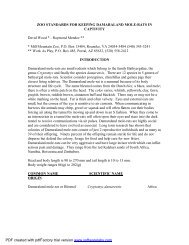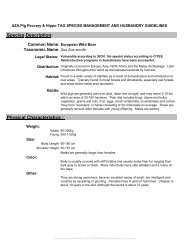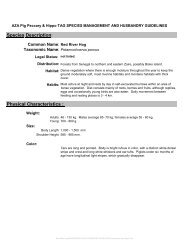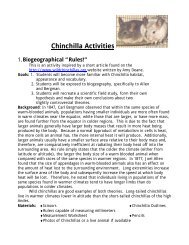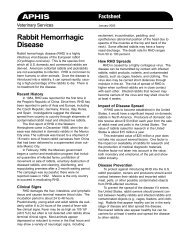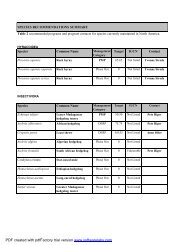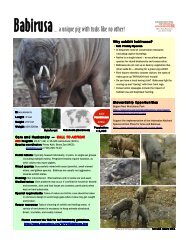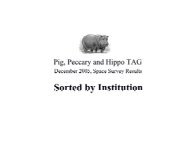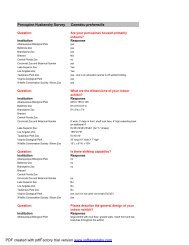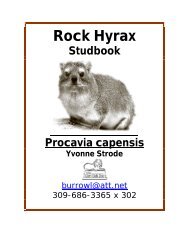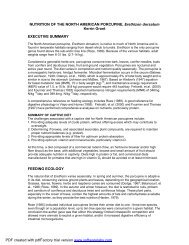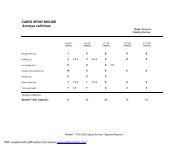Visayan Warty Pig Husbandry.pdf
Visayan Warty Pig Husbandry.pdf
Visayan Warty Pig Husbandry.pdf
Create successful ePaper yourself
Turn your PDF publications into a flip-book with our unique Google optimized e-Paper software.
AZA <strong>Pig</strong> Peccary & Hippo TAG SPECIES MANAGEMENT AND HUSBANDRY GUIDELINES<br />
Species Description:<br />
Common Name: <strong>Visayan</strong> <strong>Warty</strong> <strong>Pig</strong><br />
Taxonomic Name: Sus cebifrons<br />
Legal Status: Endangered<br />
Physical Characteristics :<br />
Weight:<br />
Size:<br />
Color:<br />
Distribution: West <strong>Visayan</strong> Island group in the Central Philippines: Cebu (extinct), Negros,<br />
Guimaras (extinct), Panay, Masbate and and Ticao islands. It should be noted here<br />
that this species is extinct over 98 % of its original range.<br />
Habitat: Lowland and montane rainforests, and monsoon rainforests. Also occur in disturbed<br />
habitats and in the proximity of cultivated foodstuffs.<br />
Habits: There have not been any detailed studies of this species in the wild. Captive<br />
observations of these animals at San Diego indicate that they are active during<br />
most parts of the day. They root and burrow and like to take mud baths and cool<br />
themselves in pools of water. When logs are offered, the pigs enjoy climbing and<br />
jumping on them. They appear to be primarily herbivorous, eating most vegetables,<br />
preferring yams, sweet potatoes also carrots and occasionally turnips. Greens are<br />
also offered along with alfalfa and bermuda hay. A high fiber feed is given daily,<br />
approximately 1 quart per adult animal.<br />
Adults: 22 to 40 kg. Males 35 - 50 kg; females 22 -36 kg<br />
Young: We do not have birth weights, estimate .25 kg, weights taken at 5-6 weeks average<br />
around 2.5-3.5kgs<br />
Body Length: 690-900 mm<br />
Shoulder Height: 300-400 mm<br />
Back Height: at top of back above shoulder 400-500 mm<br />
Ears are short approx. 50-80 mm. The body is light to dark gray almost black. Older<br />
animals get light gray to white hair mixed with the gray on their sides, front to back.<br />
Adult animals have longer hair along their spine and on the top of their head that is<br />
erected when excited or agitated. White patches of hair are also present on both<br />
sides of the nose just below the eyes. Males develop a long breeding mane with 250-<br />
400 mm long whitish gray whiskers which are grown in the fall and shed, along with<br />
the mane in February or March.(Males are much larger than females). <strong>Pig</strong>lets under<br />
6 months of age have longitudinal light stripes which gradually disappear.<br />
<strong>Visayan</strong> <strong>Warty</strong> <strong>Pig</strong> MANAGEMENT AND HUSBANDRY GUIDELINES provided by San Diego Zoo
<strong>Husbandry</strong><br />
Housing Requirements:<br />
Facility perimeter/barriers-<br />
Materials:<br />
Special Considerations:<br />
Substrate recommendations:<br />
Size of Exhibit:<br />
Rock and or concrete moats and walls, recycled plastic. Stockade fencing. All<br />
fencing and gate perimeters need to have concrete footer extending to at least a<br />
foot below the surface.<br />
Animals should not be able to chew on or lift barriers.<br />
All substrates should be natural, cushion and be non-abrasive to animals feet, such<br />
as mulch, grass or sandy soil.<br />
This can be subjective based on the group size and exhibit components. Animals<br />
enjoy variety within the exhibit and room to run. For specific concerns please<br />
consult with San Diego Zoo.<br />
Temperature tolerances:<br />
Can tolerate wide temperature fluctuations. Will rest in mud wallows and seek out<br />
other water sources to moderate temperatures. Need heat source if temperature<br />
falls below 50 degrees F. Animals of all ages require bedding and or heat source.<br />
Shade requirements:<br />
Shade and shelter need to be provided so the animal has the option to choose.<br />
Indoor/holding facilities:<br />
Materials:<br />
Size:<br />
Multiple (1 to 1.5m) gates operated by pulley systems which are hidden and<br />
protected should be available to isolate animals. Multiple holding pens with multiple<br />
entrances should be available to provide round-about access with few dead ends.<br />
This allows subordinate animals to easily escape from more dominate animals.<br />
Minimum of 100 sq ft per animal add at least 25 sq ft per additional animal.<br />
Daily Care and Maintenance:<br />
Water Delivery/Placement:<br />
Standard livestock tanks, automatically refilling livestock drinkers etc, situated in<br />
such a way as to minimize contamination, animals have a tendency to climb in and<br />
contaminate drinker.<br />
Food Delivery/Placement: Concrete feeders or a clean cement floor works well for feeding of multiple animals.<br />
Food should also be scattered in multiple dry areas on exhibit to prevent aggression<br />
and for animals to forage.<br />
.<br />
Appearance of normal Feces: 2 to 4 inch long 1/2 to 1 inch thick brown to green in color soft putty consistency.<br />
<strong>Visayan</strong> <strong>Warty</strong> <strong>Pig</strong> MANAGEMENT AND HUSBANDRY GUIDELINES provided by San Diego Zoo
Hoof trim Requirements:<br />
Weight Measurement:<br />
Social Groupings:<br />
Varies depending on individual and activity level. At this time we have not had any<br />
problems. It appears that dew claws may need attention at some point. We are<br />
monitoring. It also appears that some of the animals will be able to be desensitized<br />
to accept the nail trim free standing.<br />
Set a crate or platform on bar scales, sit at one end of crate or platform and feed<br />
animal while incrate or on platform to obtain weights. Always weigh when<br />
transporting any animal or during any veterinary procedure.<br />
Adult male with several adult females, female and male offspring. It appears that<br />
young males will be tolerated until they reach an age where they begin to compete<br />
with the adult breeding male. Probably 1.5 to 2 years of age. Young males<br />
approaching this age should be closely monitored for conflicts with the adult male.<br />
Behavior:<br />
The snout is used for excavation and play fighting, rolling logs and tipping things<br />
over are a favorite past time also. At night many pigs will share a bedding space<br />
and pile into a bedding area.<br />
Reproduction:<br />
Sexual Maturity:<br />
Gestation:<br />
Breeding behavior:<br />
Males:<br />
Females:<br />
<strong>Pig</strong>lets :<br />
About three years of age.<br />
appears to be between 120 to 155 days, probably closer to 120 days.<br />
Mating has occurred through out the year. Farrowing has occurred in March, April,<br />
May, June, July, August and December.<br />
** A nestbox must be provided for females to farrow in.<br />
breeding changes, see previous breed description.<br />
exhibit teat development around 4 weeks prior to parturition. Females have three<br />
pairs of teats.The night before giving birth the female will build a large nest in her<br />
nest box of hay that has been piled in her pen near her nest box. We provided two<br />
to three flakes of a soft bermuda hay. In every case the female was observed to go<br />
through this nesting behavior.<br />
are highly precocious, they can be heard to vocalize at day one.Sometimes they will<br />
even come out of their nestbox at day one. Usually by day two they can be readily<br />
seen and will occasionally exit the nest box.<br />
Litter Size: is generally one to three.<br />
Breeding Behavior Notes: These females are quite protective of their young and will make a charge at you.<br />
Usually the charge is just a warning to stay back, after she charges she will quickly<br />
return to her young. Females have given birth in a large group (males and females)<br />
with no problems of aggression from other members of the group. The problem<br />
arises when there are other young pigs in the group, as they will attempt to nurse off<br />
the new dam. This can cause a problem with young receiving colostrum and getting<br />
enough nourishment. Fresh moms should be separated for three to five weeks from<br />
other young animals.<br />
<strong>Visayan</strong> <strong>Warty</strong> <strong>Pig</strong> MANAGEMENT AND HUSBANDRY GUIDELINES provided by San Diego Zoo
Keeper Preparations:<br />
Keepers should provide a creep (space accessible only by the piglets). This allows<br />
for them to be fed a manna pellet and minced vegetables (see attached diet sheet).<br />
Diet:<br />
Medical Concerns/Problems:<br />
See attached diet sheets. Folivore biscuits can be used to train and reenforce<br />
behaviors. Vegetables such as apples and bananas can be used to administer<br />
medications.<br />
Litterguard has been given to pregnant females, as per veterinary instructions, to<br />
vaccinate against E. coli in order to have antibodies passed on to offspring through<br />
colostrum. At about five weeks of age an exam is performed and the young receive<br />
a microchip for identification purposes. Weights are obtained and general health is<br />
determined. The animal is then returned to the mother as soon as possible. The<br />
exam should be given far enough away so that the piglets cannot be heard by her.<br />
Training:<br />
Transportation and handling<br />
for external body exam and possible hoof or dew claw trim is more than likely. We<br />
are in the early stages of training for dew claw trims. These pigs are very receptive<br />
to training and seem to enjoy keeper pig interaction. If groups are large it is a good<br />
idea to separate out a few individuals for training.<br />
Animals can be transported in well ventilated crates, singly and by group in a<br />
livestock trailer.<br />
Be certain that very dominant animals are not confined with subordinates.<br />
When crating isolate an individual and crate when transferring from one stall to<br />
another.<br />
Animals can be desensitized to walking into a crate.<br />
** Special Note:<br />
It is very important to separate females just prior or immediately after giving birth<br />
for a period of 4 to 6 weeks. It should also be noted here that you should never<br />
separate and isolate more than one pregnant female for farrowing in the same<br />
enclosure. When one female is dominant, even slightly, cannibalization of young<br />
can occur. Always give farrowing females their own space and all should go without<br />
incident.<br />
<strong>Visayan</strong> <strong>Warty</strong> <strong>Pig</strong> MANAGEMENT AND HUSBANDRY GUIDELINES provided by San Diego Zoo




